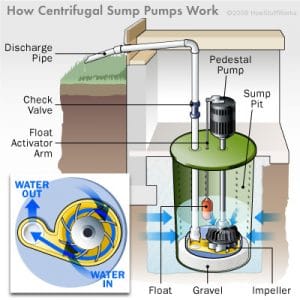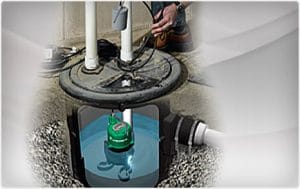A sump pump is a handy solution in case you are living in a house with a flood-prone basement. It essentially drains out flood water in the basement directly to a drain away from your house. By simply investing and installing a sump pump, you can help prevent issues during the rainy days. Other than that, you could even save a lot from repair costs which could occur due to flooding or excess water in the basement. While there are several other methods of keeping your basement free of flood or water, installing a sump pump might just be the ideal choice for you.
How does a sump pump work?
A sump pump works by simply collecting water in a sump basin which is located below your basement. Once water level rises up to a certain point, it will be the job of the sump pump to push away the water towards some drain nearby your house. There are generally two types of sump pumps – a submersible sump pump and an upright pump. Submersible pumps are placed beneath the ground, while upright sump pumps on the other hand are installed just above the ground level of your basement.

How do you install a sump pump?
In most cases, houses which have a basement will have a built-in sump basin. If in case your house has one, then installing a sump pump will be done relatively quick and easy. However, if there is no sump basin present, try getting in touch with your contractor and inquire if it is still possible to install a sump basin into your basement floor.
How to install a sump basin
You can actually do a DIY installation of a sump basin in case you don’t have one. A sump basin is often installed near your basement’s lowest point. In general, a sump basin measures 2 ft deep and 18 in wide. Therefore it is necessary to dig a hole for the dimensions of your sump basin to fit right in. Other than that, you should also consider the type, size and even the design of the sump pump you are planning to install and use.
How to adjust the sump pump
To adjust your sump pump, simply place it inside the sump pit then check its check and float valves. The check valve is used to keeping the water from flowing right back once it was driven out of the pump. Meanwhile, the float valve turns on the pump once water level reaches a certain degree. To make sure your sump pump will work properly, make sure that the float valves and check valves can move freely without any obstruction present. Majority of the sump basins have a perforated outer layer so that water can easily seep in and out of the basin. You can dig some hole on your own just in case your basin doesn’t have weep holes.

How to connect the electric supply
The electrical supply for your sump pump is basically similar to that in your house. Therefore, it is recommended to have a grounded circuit located near your sump pump so as to prevent electric shocks from happening. There are lots of sump pumps out there which come with a battery backup in order to keep operating even when there is no electricity particularly during tough weather.
Once you are done installing and fixing everything, it is then time to test run your sump pump and check the valves as well as the drainage of the pump if they are working properly. With a sump pump, you can protect your basement walls, structure and mattresses as well as some other belongings like mattress topper which might be in your basement. You can purchase mattress topper and pillows at online stores or you can get it from amazon. With a sump pump in your basement, you can protect not just yourself but your family as well from several waterborne diseases and mold buildup.
For you to take advantage of all the benefits of a sump pump, you should make sure to follow all steps carefully and properly so that your sump pump will work efficiently and without any problems. By simply installing it properly and maintaining it regularly, you could use it without any problems for longer periods of time.



